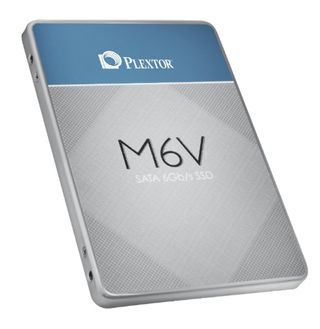Plextor Moves To 15nm NAND With M6V Series SSDs
Plextor announced the release of its M6V SSD, which is notable because it's only the second company to market with a consumer 15nm NAND SSD (SanDisk Z400s was first). Plextor even beat the manufacturers of 15nm NAND, Toshiba/OCZ, to market.
Toshiba's 15nm NAND is standard 2D (planar), which is reportedly more economical than the popular 3D NAND competition. TLC NAND has also garnered plenty of attention as it continues to gain steam (it will account for 50 percent of the NAND output this year), but many of the shipping products are still based on larger lithography nodes, which means that 15nm MLC can also compete with larger TLC NAND processes.
Plextor designed the M6V specifically to provide a slip-in replacement for HDDs, and as such, it comes in the normal 2.5" form factor, but it is also available in M.2 2280 and mSATA. The M6V comes in 128 GB, 256 GB and 512 GB capacities and features a top sequential read/write speed of 535/455 MBps. Random read/write performance weighs in at 83,000/80,000 IOPS, but there are varying performance specifications for the respective capacity points.

The M6V SSDs utilize Silicon Motion's SMI-2246 controller, which pushes performance close to the limits of the 6 Gbps SATA III interface. To take things a bit further, Plextor offers its PlexTurbo software. PlexTurbo has been in development for several years and continues to evolve to offer more features, and the latest improvements increase the performance and reliability of the software.
We covered the new PlexTurbo in-depth at Computex 2015, but in a nutshell, it provides users with DRAM caching for read and write data but reduces the chance of data loss during an unexpected power loss. PlexTurbo also offers dynamic compression algorithms that compress older files in the background with no user interaction, and a hidden folder feature that allows users to hide their (ahem) personal files in a hidden partition on the SSD. Software offerings continue to be a key differentiator for the value segment, and Plextor has one of the most robust offerings on the market.
The NAND march of progress continues onward, but we are likely seeing the last generations of 2D NAND with the current 15/16nm products on the market. The pendulum is swinging to 3D NAND in the future, but it is clear that 2D NAND still has enough performance and endurance to tide us over until 3D NAND becomes more common.
The Plextor M6V will be available in July 2015.
Stay on the Cutting Edge
Join the experts who read Tom's Hardware for the inside track on enthusiast PC tech news — and have for over 25 years. We'll send breaking news and in-depth reviews of CPUs, GPUs, AI, maker hardware and more straight to your inbox.
The M6V pricing is very competitive, with 128 GB for $65.99, 256 GB for $99.99 and 512 GB for $189.99. Prices do fluctuate, so we advise readers to check often.
EDIT: July 20, 2015, 2:45 PM: Added Pricing.
Follow us @tomshardware, on Facebook and on Google+.
Paul Alcorn is a Contributing Editor for Tom's Hardware, covering Storage. Follow him on Twitter and Google+.

Paul Alcorn is the Managing Editor: News and Emerging Tech for Tom's Hardware US. He also writes news and reviews on CPUs, storage, and enterprise hardware.
-
3ogdy 15nm TLC and all the blah blah...but you forgot to talk MONEY. What's the pricing gonna be like on this 15nm NAND SSD?Reply -
PaulAlcorn Good point :) 128 GB $65.99, 256 Gb $99.99 and 512 GB for $189.99. Adding to article as well.Reply -
JPNpower What is the point of this drive? Do they plan on outpricing the OEMs like Crucial and Sandisk/Toshiba? Or are they actually trying to sell Plexturbo?Reply -
razor512 For such a process shrink, there is very little saving being passed onto the consumer. On top of that, the reduced endurance will simply be horrible. As seen with TLC, you basically had people who were willing to give up 70% of the endurance, just to save around 15% of the cost of an SSD. With these 15nm parts, the are significantly smaller and cheaper to make, but there is literally no cost saving. compared to 19nm, and 40nm TLC designs. They are pretty much reducing the process size in order to increase profit margins.Reply -
PaulAlcorn I *finally* received endurance information, the SSD is rated at 40 GB per day, which isn't too bad in comparison to competing SSDs, for instance OCZ's TRION is 19nm TLC and has one of the best endurance ratings of the TLC crowd, and it is rated for roughly 22 GB per day.Reply
Most Popular

